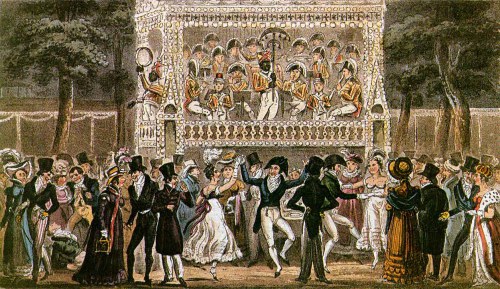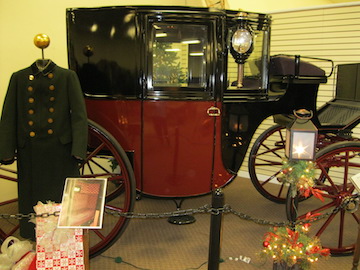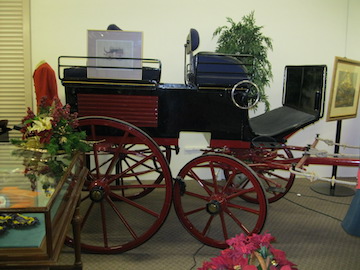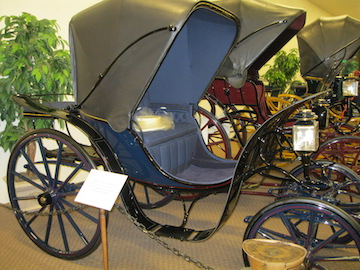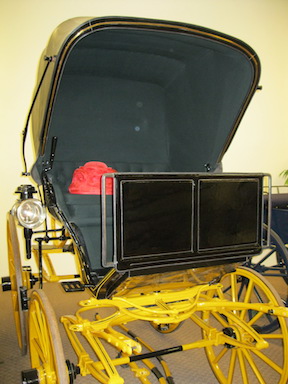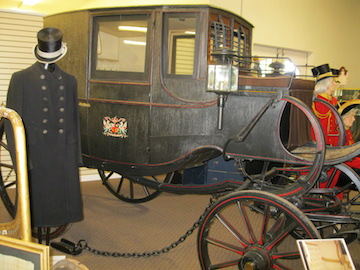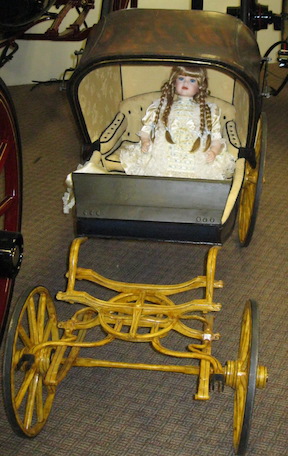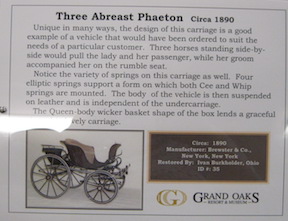Susana: Readers, I am elated to report to you that Lady Pendleton has finally granted my wish to travel back in time with her. We are going to Vauxhall—a place that no longer exists in this century—and I am going to actually stroll down the Dark Walks and see for myself what is going on behind the bushes.
Lady P: Now Susana, you will promise to behave as a proper lady would or there will be no trip to the past for you. Ever.
Susana [rolling her eyes]: Whatever you say, your ladyship.
Lady P [inspecting Susana’s clothing]: The gown your mother made you is unexceptionable, I suppose. The hair will have to do since there is no time to have Izzie [her abigail] work her magic on it.
Susana [peering into the mirror]: I think it looks fabulous with the ringlets piece added.
 Lady P: Of course you do. [Shakes her head.] Now, as for the accent… I suppose I can pass you off as American as I did with Helena [from A Home for Helena], but it would be best if you said as little as possible and allowed me to do the talking.
Lady P: Of course you do. [Shakes her head.] Now, as for the accent… I suppose I can pass you off as American as I did with Helena [from A Home for Helena], but it would be best if you said as little as possible and allowed me to do the talking.
Susana [eyes widening]: Now wait a minute…
Lady P [straightening her posture]: Do you wish to go or not?
Susana: Yes!
Lady P: Then…
Susana: I promise to follow your lead, my lady. [Aside] This is going to be great! I’ll tell you all about it when I get back!
***
I wanted to arrive by boat, but her ladyship clearly did not trust me not to overturn it and cause a scandal, so we went by carriage instead. Although it was shiny and black and carried the Pendleton crest, it was nothing like the Dress Coach owned by the Emperor Franz Josef that I saw a few weeks ago at the Carriage Museum here in Florida. The interior was a lovely purple velvet, and the seats were reasonably comfortable, although the ride was definitely jerkier than riding in an automobile. The springs were fairly good; however, I know I’d get nauseous if I ever tried to read anything in one of these things.
Entering a carriage with a long dress and train is not the easiest thing to do, even with a set of steps and coachman to hold your hand. But I assure you that leaving the carriage is even more hazardous. My foot got caught in my train and I ended up falling into the coachman’s arms. He seemed taken aback for a few seconds, and then set me firmly upon the ground and afterward straightened his fine purple and gold coat. Lady P shook her head, looked around quickly to see if anyone was watching, and then took my arm and dragged me to the entrance.
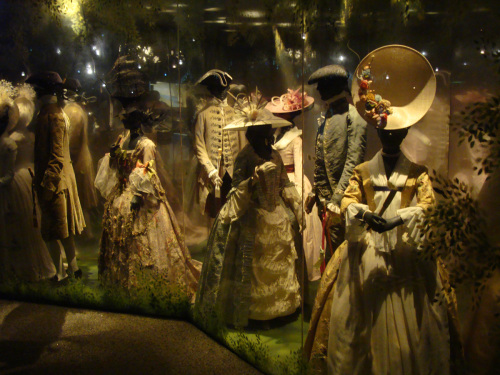
This a photo taken from a scene you can see at the Museum of London. The costumes are too early, of course, but Lady P would not let me bring a camera along, so you’ll have to imagine 1817 costumes instead.
My first impression of Vauxhall Gardens was the brilliance of the thousands of lanterns in the trees. I briefly wondered how long it took someone to light all those lanterns and how safe it was to have burning flames in trees, but then someone bumped into me and I became aware that the place was teeming with people. People of all sizes and shapes and social classes. Elegantly-dressed ladies and gentlemen with canes and reticules strolled on the same ground as working-class folk in their Sunday best. Some were dancing in front of the orchestra building while others stood on the outskirts chatting and laughing, some leaning on trees. I stood there, mesmerized by the colors, sounds, and smells until her ladyship informed me that she had bespoken a supper-box.
“Are we going to have shaved ham as thin as paper?” I asked eagerly. Everyone knows that the food at Vauxhall was overpriced. That was how they made a profit. Nothing has changed in that regard. In modern times you still pay unreasonable prices for food at airports and amusement parks like Cedar Point.
A nearby gentleman eyed me suspiciously, and Lady P reminded me that I had promised to keep talking to a minimum.
The supper-box was simply a covered nook supplied with a table and benches on three sides. The supper-box paintings were long gone, as I knew from having blogged on Vauxhall for nearly a year. I had seen some of them at the Victoria & Albert Museum, as well as the statue of Handel. I craned my neck to look around for it, but couldn’t remember where it was in 1817, since it had been relocated many times its ±200 years in the gardens. The waiter (nattily dressed in fawn breeches with a turquoise shirt and purple waistcoat) who promptly appeared to take our food order said it was in the eastern alcove on the ground floor of the Orchestra. He seemed surprised to hear that I was interested in seeing it. I guess it was old and boring to people of 1817. I seemed to recall that it was removed from the Gardens soon after. Well, tastes change over time. What attracted people in the 17th century seemed tame by the 19th century. Vauxhall lasted for so much longer than others did primarily because its owners continually sought to re-invest their profits into upgraded facilities and entertainment.

Isaac Cruikshank, A Country Farmer & Waiter at Vauxhall. A farmer in country dress, on his first visit to Vauxhall, has ordered ham in expectation of a plateful of English gammon. When the waiter brings him the notoriously thin slices that were Vauxhall ham, the farmer is furious.
Mr. Jackson (the waiter) was much more eager to tell of us Madame Saqui’s upcoming performance on the tightrope. He told us she had been a personal favorite of the former emperor Napoleon Bonaparte and had even crossed the Seine River on a tightrope. She had been performing at Covent Garden in the past year since the war with France ended, and the proprietors were over the moon to have snagged her for Vauxhall. I wanted to get up and head over to the venue immediately, but her ladyship insisted I remain until the food arrived, since she had been required to pay for it first (Waiters were more like independent contractors. They had to pay for the food themselves when they picked it up from the kitchen.)
We had plates of ham and chicken, cheese, salad, and a plate of cakes and custards, with wine to drink, which I did with good humor, even though I don’t normally drink wine. Any Regency author worth her salt should know that you don’t go around ordering water in that time period, since it wasn’t safe. Since I don’t like the taste of wine, I didn’t mind that it wasn’t of good quality. Lady P winced when she drank it, though. But she said it was definitely better than the cooking wine she had been reduced to drinking in my alcohol-free kitchen in Toledo. [She was quick to learn to pick out the good wines at the nearby liquor store, though.]
The music varied from military tunes to softer ballads and classical music, much by Handel, as Lady P informed me (being not terribly knowledgeable about music). “Cherry Ripe” and “Lass of Richmond Hill” were among them. It was simply fascinating to sit there eating and listening to the music and watching all the people enjoy the atmosphere. I had to pinch myself to make sure I was really there. In Vauxhall Gardens. In 1817. With real Regency-era people. Wow. Just wow.
More next week, same bat-time, same bat-channel!
Lady P and Susana Visit Vauxhall Gardens, Part I
An Evening at Vauxhall Gardens, Part II
An Evening at Vauxhall Gardens, Part III


